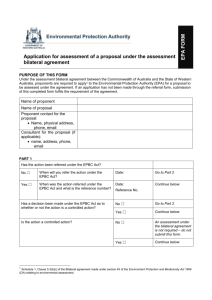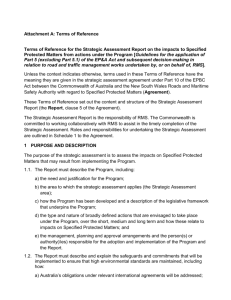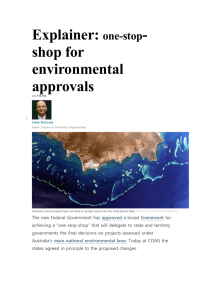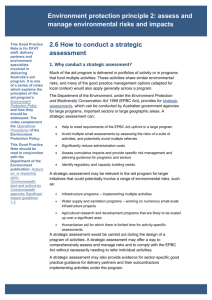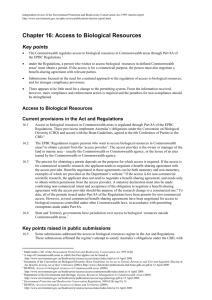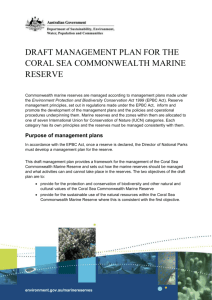Australian Government role in biodiversity conservation (PPT
advertisement
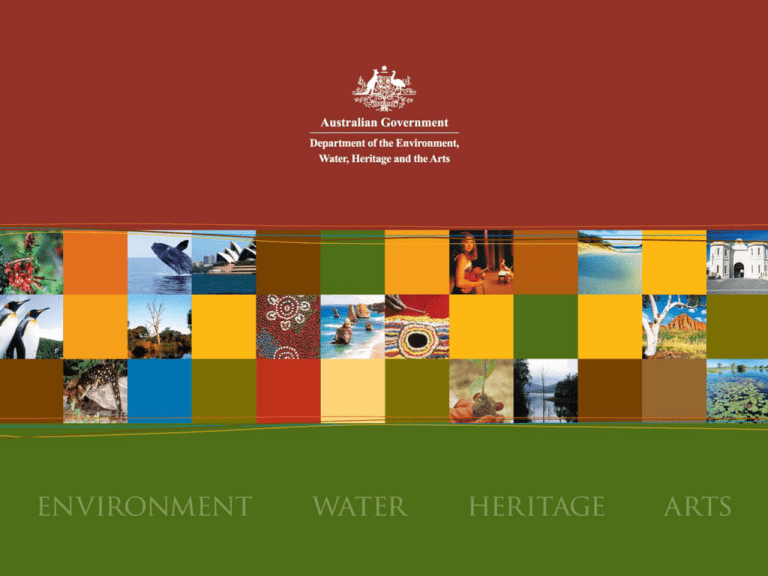
Commonwealth Government links to the National Biodiversity Strategy Overview of: •the Commonwealth Government's constitutional responsibility for the environment and in particular biodiversity •links between the draft strategy and Commonwealth Government policies and programs Commonwealth Government constitutional responsibility for the environment • Environment Protection and Biodiversity Conservation Act 1999 (EPBC Act) – matters of national environmental significance • managing Australia’s international border • managing Commonwealth lands, such as defence lands and national parks • managing Commonwealth waters – between the state/territory limit (3 nautical miles) and the boundary of Australia’s exclusive economic zone (200 nautical miles). State and territory boundaries and the EEZ Commonwealth Government policies and programs • Legislation – e.g. EPBC Act • Caring for our Country initiative – targeted $ • Marine environment • Climate change • Water • National policy frameworks EPBC Act Matters of national environmental significance • • • • World Heritage properties National Heritage places wetlands of international importance listed threatened species and ecological communities • listed migratory species • nuclear actions • Commonwealth marine environment. EPBC Act - Review Terms of reference (extract) The review will examine: – the operation of the EPBC Act generally – the extent to which the objects of the EPBC Act have been achieved – the appropriateness of current matters of national environmental significance – the effectiveness of the biodiversity and wildlife conservation arrangements. Caring for our Country ongoing initiative more than $2 billion over five years to June 2013 integrates the delivery of the Commonwealth's previous NRM programs including: - the Natural Heritage Trust - the National Action Plan for Salinity and Water Quality - National Landcare Program - Environmental Stewardship - Working on Country Indigenous land and sea ranger program. Caring for our Country ‘… seeks to achieve an environment that is healthy, better protected, well managed and resilient, and provides essential ecosystem services in a changing climate.’ Marine environment • Marine bioregional planning - 5 marine regions • Marine Protected Areas - Commonwealth reserves (under the EPBC Act) • Great Barrier Reef Marine Park Marine protected areas Climate change 3 pillars: • reducing Australia’s carbon pollution - CPRS • adapting to unavoidable climate change • helping to shape a global solution CPRS White paper - complementary measures to avoid unintended detrimental impacts – these include the NBS Water for the Future Commonwealth Government framework that provides national leadership in water reform. Water for the Future is built on 4 key priorities • Taking action on climate change • Using water wisely • Securing water supplies • Healthy rivers and waterways. Working with the states and territories – national policy work Engagement in national policy development: • • • • • • • • • Native Vegetation Framework Australian Weeds Strategy Australian Pest Animal Strategy AusBIOSEC National Water Initiative Regional Forest Agreements National Reserve System Climate change adaptation Integrated coastal zone management Private land conservation Market-based instruments - Environmental stewardship - Forest Conservation Fund - Conservation covenants Landscape scale approaches - incentives and design Complementary land-use practices - links with protected areas - connectivity Questions?

